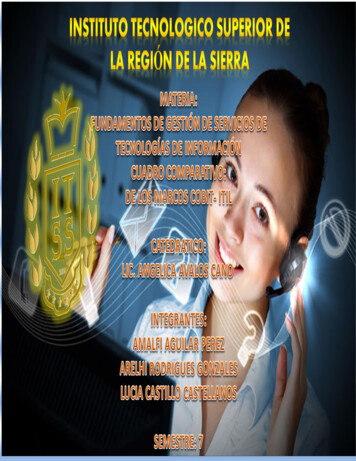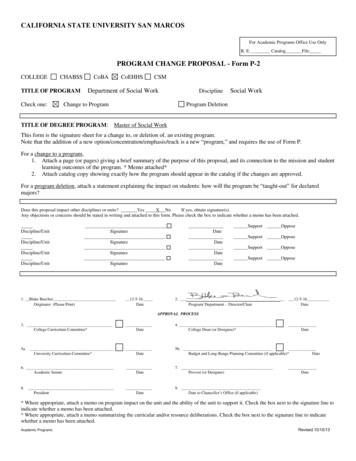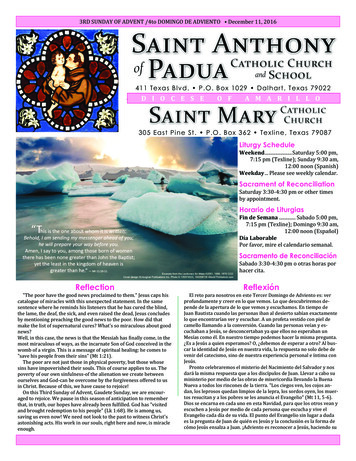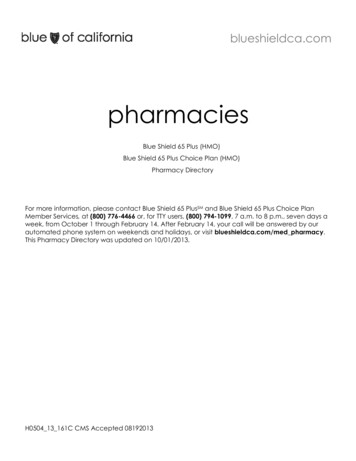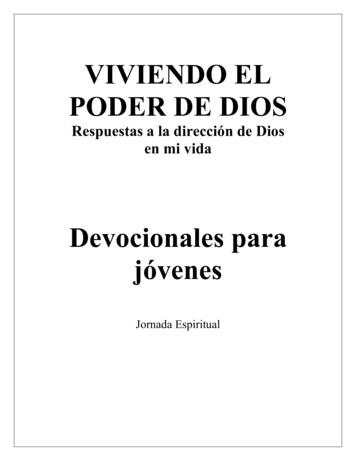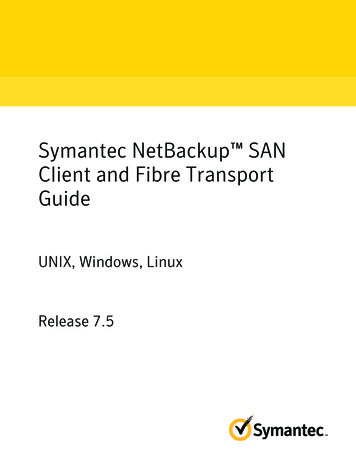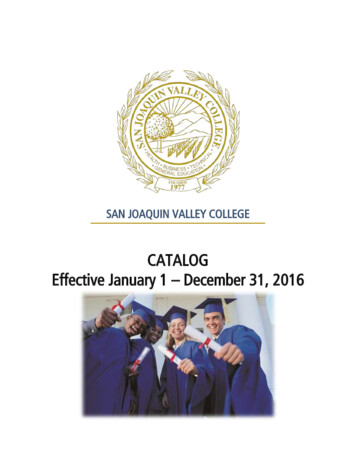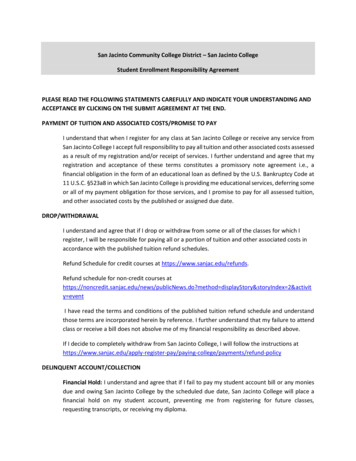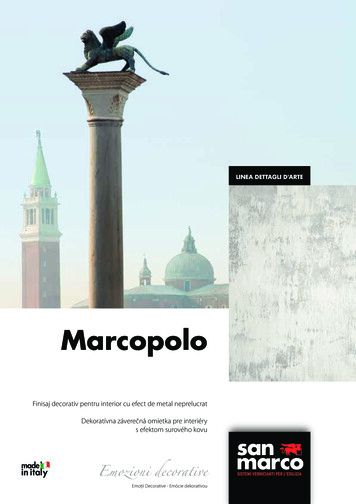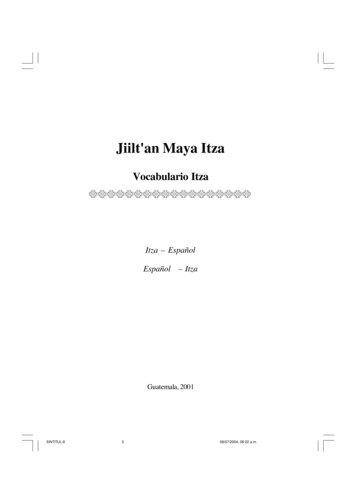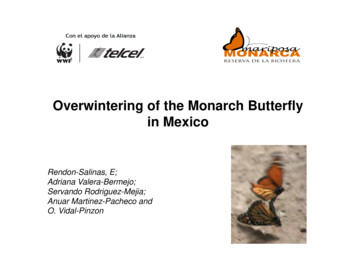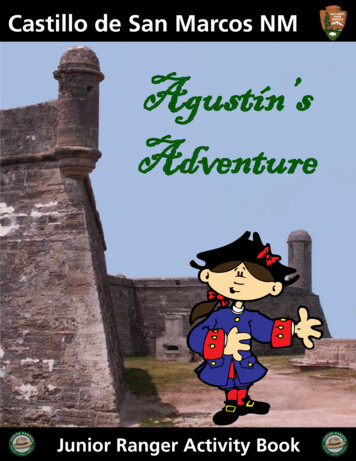
Transcription
Agustín’sAdventure
InstructionsWelcome to the Castillo de San Marcos! My name is Agustín, andI will be your guide. This Junior Ranger booklet has two levels.You may choose the level that works best for you.BasicTo receive your badge, completeSIX pages of activities.AdvancedTo receive your badge and Master Junior Rangerpatch, complete ALL pages of activities, exceptfor the color-by-numbers.While you are at the Castillo, please be safeand treat the fort with respect. Do not sit,stand, or climb on any of the cannons oron the walls of the fort. The stone the fortis built out of is very fragile to the humantouch, and we would like the Castillo to behere for many more years. We want topreserve this National Monument forfuture generations.As a Junior Ranger, it will be your job tohelp us with this! If you see your familysitting on the walls, politely ask themnot to, and tell them why.
Colonial American CitiesIn this letter, there are four underlinedcities. On the map, there are four cities markedwith stars. Draw a line to match the name of thecity to its location on the map.The letter will help you figure out wherethey are located.December, 1670To Her Most Catholic Majesty, Queen Mariana,I am writing to you on behalf of the people of the cityof San Agustín in La Florida. Our town has been leftdefenseless since the burning of our wooden fort bypirates two years ago, and we have just learned that theBritish have founded a new colony directly to the north ofus, called Charles Towne, Carolina.I am writing to beg you for the money to build a stonefort for our city’s protection. The threat of attack growsgreater every day. North of Charles Towne, the Britishlong ago settled in Jamestowne, Virginia. If Englishforces attack our city, we are left defenseless. The closesthelp would have to come from the Spanish colony in LaHabana, Cuba, far to the south of us.Queen Mariana, we beseech you, please help ourcity raise the funds for a stone fortress for our protection.Your Most Faithful Servant,Agustín1
The Columbian ExchangeThe exchange of plants, animals, and ideas between the Old World and the New World.When the Europeans came to the New World, they broughtmany new things with them. Can you label these?Castillo ConstructionThe walls of the Castillo are made out of astone called coquina. Look closely at thispicture and the walls, but do not touch.The stone is fragile.What is coquina made of?2
Parts of the Castilloshot furnacecourtyardbastionswellravelinmoatUse our brochure to learn about these parts of the fort,then fill in the sentences below !1. The in front of the drawbridge protected theentrance from enemy cannon fire.2. The was usually dry, not wet, and the Spanish could putlivestock in it if they were under attack.3. The inside the courtyard provided fresh water.4. The are the diamond-shaped corners of the fort.These allowed cannons to be placed for deadly crossfire.5. The is where soldiers practiced marching anddrilling with their muskets.6. The , which was built later by the U.S. Army,was used to heat cannonballs up red-hot to fire at wooden ships!3
Colonial LifeAnswer the questions in each box. Next to your answers, youwill read about boys and girls who lived in colonial times!What chores do you do at home?What do you do for fun?What do you want to bewhen you grow up?What do you learn at school?BoysGirlsChopping WoodFeeding AnimalsHuntingGrinding CornSpinningWeavingColonial children often did outdooractivities for fun, such as swimming,fishing, and flying ersTavern KeepersMany poorer children did not go toschool. They learned from theirparents. Boys learned to farm andhunt. Girls learned household taskslike cooking and sewing.You and colonial children still have some things in common!Many colonial kids played games that we still play today. Hopscotch, tag,dominoes, marbles, jacks, and pick-up sticks were all popular in the colonial era.4
Learn SpanishAnswer the questions in Spanish!Coloresrojo (ro-hoh)azul (ah-sool)verde (ver-day)amarillo (ah-mah-ree-yoh)marrón (mah-roan)blanco (blahn-koh)negro opasombrero (som-bray-roh)calzones (cal-sone-es)casaca (ka-sak-ah)zapatos (sah-pah-tos)chaleco (cha-leh-coh)camisa (ka-mee-sah)medias (may-dee-ahs)vueltas (voo-el-tas)sandalias stockingscuffssandalsOtrosoldado (sol-dah-doh)fusil (fyoo-seal)espada (es-pah-dah)sí (see)no (noh)Othersoldiermusketswordyesno1. The soldado’ s sombrero is with a bow.2. What color are his vueltas? His medias?3. What parts of the soldado’s uniform are azul? and .4. The soldado has una espada. Sí or no?5. The soldado is wearing sandalias. Sí or no?6. Can you see his chaleco rojo? Sí or no?5
WeaponryThe cannons were the main line of defense for the Castillo.The Spanish soldiers had to go through many steps to fire thecannons. To do this drill, they used many different tools.Here are some pictures of the cannon tools.Watch our movie to see how the cannon drill works. Draw aline to match each tool to its description, and write the orderin which they are used (Steps 1, 2, 3, and 4).Lanada (Sponge)StepAtacador (Rammer)StepCuchara (Ladle)StepSacatrapos (Worm)StepShaped like a big scoop, thistool was used to check the gunbefore it was fired.The end of this tool waswrapped in soft wool to soakup water and clean the cannon.A tool shaped like a cork-screwwas used to pull any leftovertrash out of the cannon.This tool was used to push thegunpowder and cannonball allthe way down the cannon.Did you know that cannons could fire more than just cannonballs?Chain shot is two iron balls attached by a chain.It is very good for destroying a ship’s sails.Canister is a metal can full of musket balls. It acted like a big shotgun shell.Grape shot is similar to canister, but with small cannonballs andwrapped in cloth. It looks like a bunch of grapes!6
Multiple Militaries1672: The Spanish begin construction!The Castillo has changed handsbetween countries many times overthe years, but always by a treaty oragreement, never by losing a battle.Its most important job has alwaysbeen to protect people.1763: The British arrive.Which country’s military used the fortthe longest? (Hint: which flag is bigger?)1784: The Spanish come back!1821: The United States takes over.How would YOU use the Castillo toprotect people today?1861: Confederate soldiers arrive.1862: The United States comes back!1900: The U.S. Army decides to decommission the fort,which means they no longer used it for military purposes.7
Dear Junior Ranger,Draw your picture here.My name is Ahkes. I am a Comanche Indian, and Iam 10 years old. My mom, dad, and I werebrought to the Castillo with a group of prisoners. Iwas the only child at the fort. It was lonely, but Iliked to draw pictures for fun. The jailor bought ussketchbooks, crayons, colored pencils, andwatercolors. I drew pictures and sent them to myfamily out west. I was imprisoned here from 1875to 1878, but I am sure it looks different now.Draw a picture of what the fort looks like today.Include all the interesting things you see.This is an example of ledger art, a type of NativeAmerican artwork usually done on paper. CaptainPratt bought sketchbooks for prisoners at the fort.This image shows the first Pow Wow in Florida,performed by prisoners inside the Castillo.8
The National Park Service at the CastilloAsk a Ranger or Volunteer!Why do you like working with the National Park Service?SignaturePresident Calvin Coolidge made the Castillo de San Marcos a NationalMonument in 1924. Almost ten years later, the National Park Service took overthe care of the fort. Since 1933, the National Park Service has cared for theCastillo, preserving the site for future generations to visit and enjoy. Today,most of the standing structure is original. Visiting the fort is like taking a stepback in time. When you look at the walls of the fort, you are seeing the samebuilding that Spanish, British, and American soldiers looked at one hundred, twohundred, and even three hundred years ago. This is one of the oldest structuresin the United States, and it is the job of the National Park Service to make sure itremains standing for another one hundred, two hundred, or even three hundredyears. Park Rangers love working at our National Parks.You may also meet a Volunteer at theCastillo, someone who spends their timehelping people without being paid. Someof the Volunteers dress in soldiers’uniforms and fire the cannons on theweekends!9
The ArrowheadThe Arrowhead is the officiallogo of the National ParkService. Each symbol in thelogo represents somethingwe have a mission topreserve or protect.Arrowhead: History & ArcheologySequoia Tree: PlantsMountain & Lake:Scenery & RecreationBison: WildlifeThink about what youhave seen and experiencedwhile visiting the fort.Create and label your ownlogo for the Castillo!10
“Leave nothing but footprints, take nothing but pictures.”When we recycle, we take old, used items and turn them intonew things. If we recycle, then we don’t leave behind as muchtrash. In colonial St. Augustine, people reused almost everythingbecause it would take a very long time to get anything new. Oldclothes were turned into cleaning rags. Old metal could bemelted down to make new tools.What can YOU recycle at home?Cross out which things DO NOT belong in the tsPark RangerFood andDrinkYou!(Draw a pictureof yourself.)11
Reflect On Your VisitThe National Park Service is dedicated to preserving the Castillo deSan Marcos because it is an important part of American history.Take time to think about why this place is so important.What have you learned at the fort? List at least three facts that youdidn’t know before you visited the Castillo.In your opinion, why should we preserve theCastillo for future generations of Junior Rangers?12
Imagine you are living in St. Augustine when an enemyattacks. Write a letter to your relatives in Spain. Are you a soldierdefending the Castillo, or a civilian taking care of your family athome? Are you afraid? What do you think will happen?If you can’t finish your booklet while you’re here, please mail it tous! We will return the book along with your badge and patch.Master Junior Ranger1 South Castillo DriveSt. Augustine, FL 3208413
Color-By-Numbers to Do At Home!Spanish SoldierBritish Soldier33221211122113333141. Red2. Dark Blue3. BlackThe bow on his hat is redand the trim is yellow. Hisbuttons are brass.331. Red2. Dark Blue3. BlackThe bow on his hat is black,and the trim is white. Hisbuttons are silver.
Color-By-Numbers to Do At Home!Confederate SoldierUnion Soldier111111223311122331. Grey2. Blue3. BlackHis buttons are copper.331. Dark Blue2. Light Blue3. Black.His buttons are brass.15
Connections to Our History!Fort Mosé Historical State ParkIn 1738, the Spanish governor ofFlorida chartered Gracia Real de SantaTeresa de Mosé, or Fort Mosé, thefirst legally free black settlement inNorth America. The fort was built onthe edge of a marsh, two miles northof St. Augustine and the Castillo. In1740, when British soldiers attackedSt. Augustine, Fort Mosé was abandoned at first, but the bravemilitiamen of Mosé recaptured theirhome from the British and forcedthem to retreat back to Georgia.Fort Matanzas National MonumentFifteen miles south of the city of St.Augustine, there is a small inlet intothe Matanzas River. After the attackby the British in 1740, the Spanishrealized if they were attacked again,the enemy could block that inlet tokeep supplies from reaching theCastillo. To prevent this, the Spanishstarted building Fort Matanzas inautumn of 1740. Shortly before it wasfinished in 1742, the British tried tocome through the inlet. FortMatanzas fired two shots, and theBritish retreated.Become a Junior Ranger at Fort Matanzas as well!16
Castillo de San Marcos National MonumentThe Castillo de San Marcos is the oldest masonry fortification in NorthAmerica. It was constructed between 1672 and 1695 under the Spanishgovernment with labor from the local Timucuan Indians. British forcesobtained the fort in 1763 as a result of the French and Indian War, but theSpanish regained control in 1784 at the end of the American Revolution.Florida became a United States territory in 1821, and the Castillo, renamed FortMarion, was used as a supply depot, a military base, and a Native American prison over the years. The fort was named a National Monument in 1924, and theNational Park Service restored its original name, Castillo de San Marcos, in1942. Today, the Castillo is an immensely popular tourist attraction, and ithelps tell the unique story of St. Augustine, the oldest continuouslyinhabited European settlement in the United States.Visit us online at www.nps.gov/casa
us! We will return the book along with your badge and patch. Master Junior Ranger 1 South Castillo Drive St. Augustine, FL 32084 Imagine you are living in St. Augustine when an enemy attacks. Write a letter to your relatives in Spain. Are you a soldier defending the Castillo, or a civ
